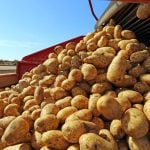A new analysis of 450 genomes from cultivated potatoes and 56 genomes of wild potato species has revealed that the potato lineage originated through natural interbreeding between a wild tomato plant and a potato-like species in South America about 9 million years ago.

Evolutionary origins of the potato revealed – and a tomato was involved
Study, which analyzed genomes from cultivated and wild potatoes, may improve future breeding

In one giant leap for Earth plants, seeds are grown in moon soil
Washington | Reuters — Scientists for the first time have grown seeds in soil from the moon — samples retrieved during NASA missions in 1969 and 1972 — in an […] Read more

Locust swarming pheromone identified in step toward curbing plagues
Washington | Reuters — Scientists have identified a chemical compound released by locusts that causes them to swarm, opening the door to possible new ways to prevent these insects from […] Read more

U.S. regulators allow GM cotton as human food source
Washington | Reuters — U.S. regulators on Friday gave the green light for genetically modified cotton to be used for human consumption, paving the way for a protein-packed new food […] Read more

World’s oldest bread found at prehistoric site in Jordan
Washington | Reuters — Charred remains of a flatbread baked about 14,500 years ago in a stone fireplace at a site in northeastern Jordan have given researchers a delectable surprise: […] Read more

Scientists peel back carrot’s genetic secrets
Reuters — Scientists have gotten to the root of the carrot, genetically speaking. Researchers said Monday they have sequenced the genome of the carrot, an increasingly important root crop worldwide, […] Read more

Wild bees seen dwindling in main U.S. crop regions
Washington | Reuters — Wild bees, crucial pollinators for many crops, are on the decline in some of the main agricultural regions of the U.S., according to scientists who produced […] Read more
Rising CO2 levels may cut nutrient levels in crops: study
Washington | Reuters — Rising levels of carbon dioxide (CO2) in the atmosphere may cut the nutritional quality of some of the world’s most important food crops, researchers reported Wednesday […] Read more
Scientists make ethanol without corn or other crops
Washington | Reuters — Scientists said Wednesday they have developed a new way to make liquid ethanol efficiently without using corn or other crops needed in the conventional method for […] Read more
